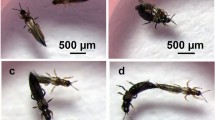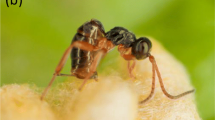Abstract
The absence of species that show facultative variation in reproductive mode within populations1–4 has thus far severely hindered study of the selective pressures associated with oviparity and viviparity. Here I report that females of the mycophagous thrips Elaphrothrips tuberculatus (Insecta: Thysanoptera) are facultatively viviparous and produce male offspring by viviparity and female offspring by oviparity. Individual females can switch between the two reproductive modes. Females produce fewer offspring when viviparous than when oviparous, but the survivorship of viviparous offspring is sufficiently high that the average number of pupal offspring produced by females in each mode is similar. Facultatively viviparous thrips provide the first experimental systems for analysing the behavioural, ecological and physiological causes of variation in reproductive mode.
Similar content being viewed by others
References
Blackburn, D. G. thesis, Cornell Univ. (1985).
Blackburn, D. G. Amphibia-Reptilia 6, 259–291 (1985).
Tinkle, D. W. & Gibbons, J. W. Misc. Publs Mus. Zool. Univ. Mich. 154, 1–55 (1977).
Shine, R. in Biology of the Reptilia Vol. 15 (eds Gans, C. & Billett, F.) (Wiley, New York, 1985).
Crespi, B. J. Anim. Behav. 34, 1324–1335 (1986).
Crespi, B. J. thesis, Univ. Michigan (1987).
Crespi, B. J. J. Insect Behav. (in the press).
Priesner, H. Z. wien. ent. Ges. 43, 247–249 (1958).
Crespi, B. J. Evolution 42, 1199–1211 (1988).
Risler, H. & Kempter, E. Chromosoma 12, 351–361 (1961).
Stannard, L. J. Ill. nat. Hist. Surv. Bull. 29, 215–552 (1968).
Fisher, R. A. The Genelical Theory of Natural Selection (Oxford University Press, 1930).
Seger, J. Nature 301, 59–62 (1983).
Williams, G. C. Adaptation and Natural Selection (Princeton University Press, New Jersey, 1966).
Blackburn, D. G. & Evans, H. E. Am. Nat. 128, 165–190 (1986).
Shine, R. & Bull, J. J. Am. Nat. 113, 905–923 (1979).
Ananthakrishnan, T. N., Padmanaban, B., Dhileepan, K. & Suresh, G. Occ. Publs ent. Res. Inst. Loyola College, Madras 5, 1–37 (1984).
Haga, K. XVIth Int. Congr. Em. Kyoto, Japan, Workshop: Conf. Thysanopterists 1–8 (1980).
John, O. Ent. Mitteil. 12, 227–232 (1923).
Author information
Authors and Affiliations
Rights and permissions
About this article
Cite this article
Crespi, B. Facultative viviparity in a thrips. Nature 337, 357–358 (1989). https://doi.org/10.1038/337357a0
Received:
Accepted:
Issue Date:
DOI: https://doi.org/10.1038/337357a0
- Springer Nature Limited
This article is cited by
-
Exceptional parallelisms characterize the evolutionary transition to live birth in phrynosomatid lizards
Nature Communications (2022)
-
Maternal Care, Iteroparity and the Evolution of Social Behavior: A Critique of the Semelparity Hypothesis
Evolutionary Biology (2013)
-
Subsociality and female reproductive success in a mycophagous thrips: An observational and experimental analysis
Journal of Insect Behavior (1990)
-
Diversity of little things
Nature (1989)





